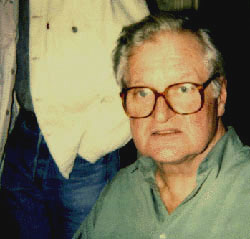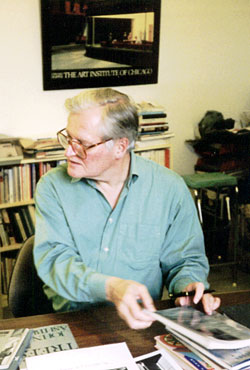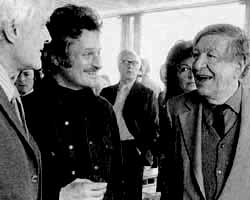
| Jacket 2 — Early 1998 | Jacket 2 Contents | Jacket Homepage | Search Jacket |
This piece is about 6 printed pages long.
It is copyright © John Tranter and Jacket magazine 2009. See our [»»] Copyright notice.
The Internet address of this page is http://jacketmagazine.com/02/3jas.html
This is a basic introduction to some themes in John Ashbery’s poetry. John Tranter came across Ashbery’s writing in the 1960s. Here he reflects on the schizophrenia of fame.
This piece is 2,500 words or about 8 printed pages long.
THERE ARE THREE John Ashberys. The first is the boy who grew
into the man who became a scholar and artificer of words. I call
him the Primary or Mundane Ashbery. After a youth spent on a
fruit farm in upstate New York he attended college and then Harvard
University. He gradually turned into another person, a poet; the
poet who wrote all those poems, plugging on year after year, one
sheet of paper after another rolling through the Remington, until
some sixteen of his works stand there on the shelf to entrance and
puzzle us.
So the poet is not that boy, but another person. What did Rimbaud say? “I” is another. And this “Secondary Ashbery”, as I shall call him, is not so much a person as a gifted creature, the enchanted one who spins the golden threads that the reviewers and critics are obliged to untangle and weave into their own explanation of its pattern. He is never met with in his tower, never seen, never spoken to. Friends have only caught a glimpse of this elusive creature, who even as they enter his study is invisibly, swiftly and silently replaced by a simulacrum. For when Mr Ashbery is meeting, seeing others and being seen by them, listening and speaking, eating and drinking and sharing a joke, he is not that poetry writing person, but once again the man who used to be the boy who grew up on a remote farm, the Primary or “Mundane Ashbery”.
This mundane manifestation is currently a tall, wide-shouldered man nearing seventy with a slight limp and a courteous, diffident and kindly manner that conceals - almost successfully - a brilliant mind and a wit that revels in gossip as much as in learning. The Mundane Ashbery has a love of old poetry in English and modern prose in French, and of modern art, ballet and music. He has spent his adult life in Paris and New York City. When he reads from his books, in that vague and charming drawl that asks you not to take this stuff too seriously, he looks at certain moments as the Secondary Ashbery might look, hesitant under the reading lamp, searching for the right word.

John Ashbery, Sydney, 1992
Photograph © John Tranter, 1997
Then there is the Tertiary or Transcendental Ashbery. That’s the Ashbery people refer to when they say ’Have you read the latest Ashbery?’ or ’What do you think of Ashbery? Better than Wallace Stevens, huh?’ The Transcendental Ashbery is usually presented as just the surname, a complex image at one remove from the human: it has little to do with either of the other Ashberys, and leads a largely independent
life.
It gradually solidified out of the mists of personal obscurity into a glittering nodule of recognition around 1970, helped by the publication of An Anthology of New York Poets. This collection, edited by the younger poets Ron Padgett and David Shapiro and published in June of that year, mounted his writing at the prow of the so-called ’New York School’ and placed him as father-figure to a generation, along with Edwin Denby, Kenneth Koch, James Schuyler and the recently-dead Frank O’Hara.
This Transcendental Ashbery underwent various adaptive changes as it bumped into different consumer resistances and approvals, and mutated into the ’New, Readable Ashbery’ during the northern fall of 1975, when the book Self-Portrait in a Convex Mirror won the Big Three Prizes available to American poets: The Pulitzer, the National Book Critics Circle Award and the National Book Award.
There’s something holographic about the Transcendental Ashbery. It seems to float about two or three inches above the page of the magazine you’re reading in the café, pulsing and phasing in and out of focus under the neon. It occupies the same cognitive space as the brand name of the mineral water you’re drinking, and that fact gives us a clue to its nature: it is a collective cultural representation like ’Apple Pie’, ’Tide’ or ’Postmodernism’.
Just as the material form of the actual Tide washing powder has changed its physical substance as well as its packaging over the decades, shedding the too-abrasive qualities of ’bleach’ and ’power to clean’ and taking on the more nurturing qualities of ’enzymes’ and ’bio-degradability’ while still washing our clothes and retaining its ’identity’, so ’Ashbery’, or ’J.A.’ as it is sometimes known, has metamorphosed in diverse ways. In the late fifties it transmuted from a gentle, gawky kid producing sweet-natured and slightly wacky lyrics into a fierce and frowning European intellectual, a monster who would tear the heart from a living poem and stuff verbal garbage in its place. Further revisions have occurred, each modulating the aura of the Transcendental Ashbery: ’Delphic Darling of Yale’, ’Mellow Old Guy’, and so forth.
Of course there’s a space between the Primary and the Secondary Ashbery, and as usual he’s the best person to talk about it, which he does in the poem ’A Sedentary Existence’:
Sometimes you overhear them discussing it:
the truth - that thing I thought I was telling.
What could it have been that I said?
To be more or less like other men or women
. . . - it’s
like writing a book that is both beautiful
and disgusting.
Because we can’t do it now. Yet this space
between me and what I had to say
is inspiring.
Of course it’s inspiring, or he wouldn’t be there.
The Secondary Ashbery has always been teased by the idea of what he might look like in a poem. Here he is reflecting on a portrait of himself in the mirror of his poem ’The Art of Speeding’: ’I’m the cap and bells that don’t belong. / A free-lance artist. The last and first of the romantics.’
The Last of the Romantics? Maybe so.
Why ’J.A.’? Let me divagate. Put a seventeenth-century English poem into a blender with a 1930s American snapshot and you’ve got the early 1950s Ashbery poem ’Portrait of Little J.A. in a Prospect of Flowers’, a neat piece of modern ekphrasis. The rhetorical device of “ekphrasis” is as old as Homer, and involves the verbal description, usually in a poem, of a piece of visual art, usually a painting or sculpture.
In his 1950s piece of ekphrasis, the Secondary Ashbery describes how the image of the young Mundane Ashbery appears to him in the family snap: ’Yet I cannot escape the picture / Of my small self in that bank of flowers: / My head among the blazing phlox / Seemed a pale and gigantic fungus.’ Now get this straight: we’re looking over his shoulder with him, at him as a boy looking at the camera, that is, looking back at himself (and us, and us!) in the future reading these lines.

John Ashbery, Sydney, 1992
Photograph copyright © John Tranter, 1992, 2010
This Ashbery piece is named after a lovely poem by the metaphysical poet Andrew Marvell (1621-1678), a picture of a friend’s child titled ’Portrait of Little T.C. in a Prospect of Flowers’. “Metaphysical” is a label that would perhaps fit the brooding aspirations of the young Primary or Mundane Ashbery, confronting, from Deerfield Academy and later from Harvard and Columbia universities in the aftermath of World War Two, the terrors and delights of the Twentieth Century. The initials ’J.A.’ are stamped in gold leaf on the front cover of the hardback version of his book Hotel Lautréamont, as though to reinforce the connection with the earlier poem.
The label ’metaphysical’ also fits one of the qualities of his body of writing, that is, the Transcendental Ashbery. Where ’meaning’ can be teased out of the weave, or rather the felt, of those casual masterpieces of his, it often revolves in brilliantly ironic and paradoxical ways around the themes of sex, love, loss, death, individual identity and the weather. The metaphysical poetry of the seventeenth century was about the eschatological implications of just such passions, inscribed against a background of civil strife in a rapidly modernising world.
Well, what is the Transcendental Ashbery about? Let me count the ways: it is about weather, particularly involving trees, leaves and flocks of birds. It is about shadowy fall evenings in a deserted schoolyard, the teacher alone in the empty classroom and the ghostly image of a lost or dead boy fading around a corner in the distance. It is lacustrine, a Latinate word Ashbery plucked from the dictionary for the title of his poem ’Those Lacustrine Cities’: about lakes, and pools, and rivers, and shores, and the waves of the ocean. It is about art, pots of paint, canvasses, theatre sets, late night parties, a half-forgotten scent, scenes from a ballet, performances of impossible music and sleigh rides over the tundra. It is about farms like the ones around where he grew up near the shores of Lake Ontario in upstate New York: cold, dark and silent in the long northern winter, with brooding weather and flocks of migrating birds to match.
In this richness of both natural and cultural material, his writing is a continuation of the long project initiated by the Romantics - a dialogue that notices the flow of natural and social energies and weaves them together into a series of insights, compacting metaphysics and literature into a critical mass that gives out a glow of meaning. It’s the Coleridge of the letters and the notebooks who comes to mind, the talkative theorist who invented the great brand-name of Romanticism, “Organic Form”.
In Ashbery there is also a willingness to incorporate humour into the text of his meanings, and an agility that is an openness to chance fluctuations of the world’s attention, but more than that too. Nature in flux keeps breaking in, and he reminds us that that’s important.
But, being a modern poet, his work is also about its own machinery. He’ll drag an ancient and ornate form like the pantoum or the villanelle down from the attic, dust it off, kick over the motor and take it for a run through the streets. He’ll come across Donne’s ’A Valediction: Forbidding Mourning’ written some three centuries ago, and in response write a poem called ’A Mourning Forbidding Valediction’ whose main purpose, I suspect, was to give him the opportunity to rhyme ’cardigan’ with ’ptarmigan’.
He can invent conjunctions no one else would have imagined. Take the phrase ’I can hear the toad crooning’. Such an image, once contemplated, bedevils the memory. It might well have come from the imaginary book he mentioned in the poem I quoted earlier, the book that is ’both beautiful and disgusting’.
He does worse things. Take, for example, if you will, the poem ’Farm Implements and Rutabagas in a Landscape’. The quaint title came from a print he’d seen in a gallery storeroom one day. Though a vegetable takes a leading role in the poem, it’s not a rutabaga (a swede, or Swedish turnip) but a spinach. The poem’s a sestina, an obstinate form in which the end-words of each of the six lines in the first stanza are repeated as end-words of the other five six-line stanzas, and are also embedded in the final three-line stanza. The mediaeval troubadours invented and then exercised the sestina almost to death, and most poets since have had a crack at it. But having chosen vegetables as a theme, who would go so far as to use the word ’spinach’ as an end-word, repeated six times? It’s one of the many unrhymable words in English, but is that reason enough? And what are Popeye and Olive Oyl doing in there? It’s the spinach again, isn’t it? And who would end a sestina: ’Popeye chuckled and scratched / His balls: it sure was pleasant to spend a day in the country.’?
Why, one of those John Ashberys, that’s who.
Most writers never manage the Escape Velocity to tear free of the gravitational pull of their audience, let alone of their cultural setting. Coleridge said of Wordsworth that an innovative poet should be twelve years ahead of his time. As we know, Wordsworth got stuck in the tar-pit of his self regard, and his
audience caught up with him soon enough.

Stephen Spender, John Ashbery, W.H. Auden at Poetry International London, 1972. This was the period during which John Ashbery adopted what he later dubbed his “Mexican Bandit Look”. Auden had written the Introduction to Ashbery’s 1956 Yale Younger Poets book Some Trees. In the original uncropped photo, an ambitious Joseph Brodsky is muscling in from the right.
Ashbery is different. His first book (Some Trees, 1956) was lyrical, brilliant, but quirky, and in the era of Eisenhower and the Cold War it didn’t find many readers, selling less than its edition of 800 copies in eight years. He lived and worked in France from 1955 to 1965 and went on writing, imagining that no one would ever want to publish or read his work, beyond a small circle of friends. The poems he wrote in Europe in the late 1950s were mostly incomprehensible collages. More by chance than design they did find a publisher, and became his second book, The Tennis Court Oath, a work that puzzled many readers and infuriated most critics. Wallace Stevens said that a poem should resist the intelligence ’almost successfully’. With the Ashbery of The Tennis Court Oath, the intelligence doesn’t have a chance.
Having discovered freedom almost accidentally, the Secondary Ashbery went on writing in relative obscurity, doing just what he felt was right. It took almost twenty years from his first book before the booster rocket of Yale criticism ignited and propelled him into his present position drifting in Earth orbit, lit from below by the glow of fame. One thinks of Laika the Russian space dog, peering wistfully down on the inhabitants of Earth as the planet revolves slowly beneath.
There he goes, blinking into the west…